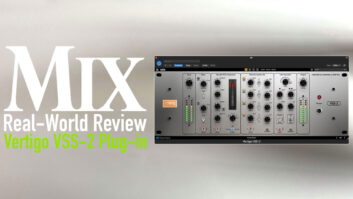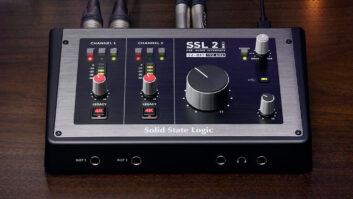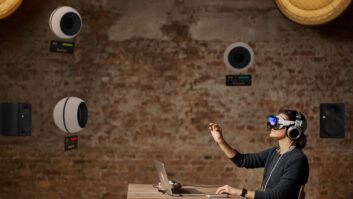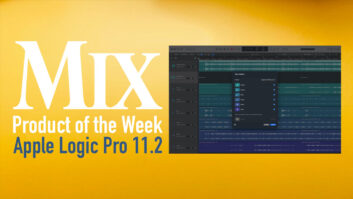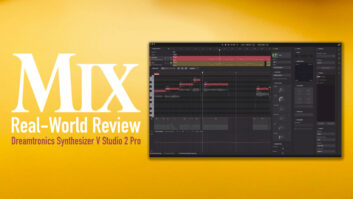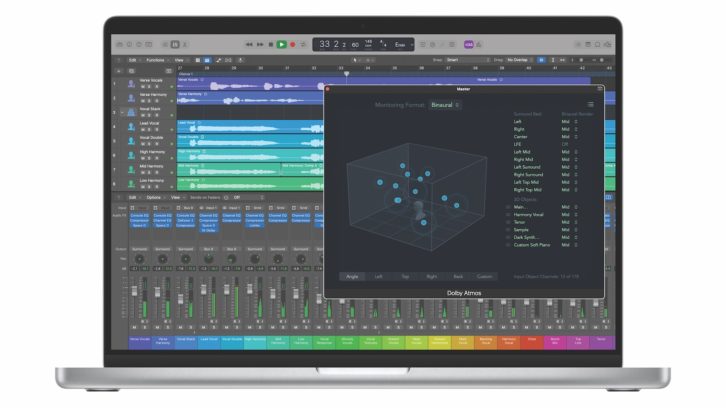
While Apple’s marketing and the attention of the media have largely focused on the Apple Music Spatial Audio and lossless audio rollouts to consumers, there is plenty for professionals to get excited about. Apple has always been about the tight integration of its software and hardware, and it’s certainly evident in its approach to audio and video.
Take the new MacBook Pro models. Available in two sizes, with either a 14- or 16-inch display, these notebooks are fully optimized for all media-makers, not just audio pros. The full spec and options are far too extensive to detail here. Suffice to say, the key to the power of these new machines lies with Apple’s new M1 Pro and M1 Max chips, which deliver up to 4x faster performance than the M1 chip—not to mention competing products—while using 70 percent less power. Retail prices range from $1999 to $3499.
Apple Goes Spatial – Part 1: What’s It All Mean?
According to Xander Soren, Director, music apps product marketing, Apple, “One of the most profound increases in performance we’ve ever seen for the Mac is the M1 Pro and the M1 Max. This is workstation desktop-class performance on a notebook. And Logic is highly optimized to take advantage of that.”
Even in a live recording situation, he says, the new MacBook Pro machines can host a stack of power-hungry plug-ins. “We’re seeing up to three times the amount that you can put on a channel strip compared to the previous generation 16-inch MacBook Pro, which was a great, powerful system at the time.”
Both notebook models incorporate four force-canceling woofers (a design familiar to Barefoot monitor users) and two mid/high tweeters capable of delivering a convincingly immersive soundstage. Apple has also upgraded the built-in mics to a three-element array with directional beamforming and macOS’s Voice Isolation filtering. Oh, yeah, and there’s an impedance-sensing 3.5mm headphone jack, along with three Thunderbolt 4 ports and an HDMI port.
For more critical monitoring, the new third-generation AirPods redesign brings it into line with AirPods Pro and AirPods Max to also support the dynamic headtracking and Adaptive EQ necessary for a more realistic 3D audio headphone experience.
Immersive audio is best experienced through over-the-ear headphones that direct sound at the pinna, so AirPods and AirPods Pro earbuds use directional filters to optimize the 3D effect. (More about headtracking in the “Spatial Audio” and “HRTF” sidebars.)
ADD THE LOGIC SOFTWARE
That brings us to Logic Pro 10.7, the 35th free update to users of Apple’s digital audio production software since launch. Apple no doubt has its reasons for not labeling this Logic Pro 11, but make no mistake, it’s a major update.
For starters, Logic Pro 10.7 integrates the full suite of Dolby Atmos mixing tools, including object panning and 3D visualization, as well as the full menu of monitoring and rendering options. To be clear, this new update includes all the functionality of Dolby’s standalone software. While Dolby Atmos Production Suite is a $299 add-on for other DAWs, the price for this updated Logic Pro app remains unchanged at $199.
For good measure, Apple also upgraded 13 of its plug-ins to 7.1.2 operation in Logic Pro 10.7, including the Space Designer convolution reverb. All of the surround-sound impulse responses previously available are now Atmos-compatible. In addition to adding more loops and sounds, the updated app also includes a complete Dolby Atmos session of “Montero” by Lil Nas X, plus a spatial audio demo grid, two instructive resources.
Logic Pro operates in two modes: Complete or Simplified. By selecting Complete mode in Preferences, audio pros can configure a Dolby Atmos project through a submenu in the Mix dropdown menu and apply Dolby’s 3D panner plug-in on the required channels. Simplified mode streamlines Logic’s features and is intended for novices and users stepping up from GarageBand.
Optimized to run on the new MacBook Pro models, Logic Pro 10.7 can support a massive number of tracks and plug-ins. In a demonstration of the setup’s capacity, Apple played me a Dolby Atmos session mixed by Steven Wilson comprising 1,000 tracks of live orchestra plus 500 virtual tracks, with plug-ins galore. The machine didn’t break a sweat.
How-To: Apple Spatial Audio Explained
Previously, the means to produce and mix a song in Dolby Atmos—a computer for the DAW and another for the renderer, typically linked by a Dante network and associated interfaces; Dolby Atmos Production Suite software; an upgrade to at least 11 speakers and a sub; a monitor controller; plus integration and certification and, of course, a room—were accessible only to those with a hefty five- or six-figure budget. Now, while you could pay more if you load up the laptop options, the entry-level buy-in is under $3,000 for a 14-inch MacBook Pro with M1 Pro chip, Logic Pro 10.7 software and a pair of third-gen AirPods.
This easy access to spatial audio tools is all part of Apple’s grand plan. “We want to help people create in a much simpler way,” says Soren. “It’s the democratization that was really important to us. We want all musicians to be able to mix their songs in spatial audio themselves and publish them to Apple Music.” With that all-Apple gear list, he says, “I think it’s kind of a revolution in terms of ease of use and pricing. You really have everything a musician needs to start mixing their music in spatial audio.”
Apple would like nothing better than for its immersive audio tools to become commonplace in the hands of all creatives. “I think what you’re going to see over time is that the artists are going to want to get more hands-on with the spatial audio mix,” Soren says. “We’re seeing that already when we show this to artists: ‘I want to take the first pass and decide how my music is going to get placed.’”
Some will mix with a more traditional, natural approach, Soren says, while others will experiment. “If you’re producing a jazz quartet, you want to feel like you’re in the room. And I think a lot of electronic and hip-hop artists are going to want to do interesting things with movement and automation.” The unforeseen creative potential of Apple’s spatial audio products in the hands of artists is inspiring, he says: “They’re going to surprise us and do things we never dreamed of.”
Click on for Apple Goes Spatial – Part 3: The Artist And The Engineer


